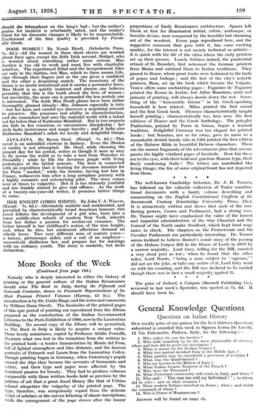More Books of the Week
(Continued from page 193.)
Nobody who is deeply interested in either the history of printing or the general culture of the Italian Renaissance should miss The Book in Italy, during the Fifteenth and Sixteenth Centuries, shown in Facsimile Reproductions of the Most Famous Printed Volumes (Harrap, £5 5s.). The introduction is by Dr. Guido Biagi, and the notes and comments by William Dana Orcott. The facsimiles of the printed pages of this epic period of printing are reproduced from the Album prepared as the contribution of the Italian Governmental Libraries to the Paris Exhibition of 1900, now in the Laurentian Building. No second copy of the Album will be permitted, so The Book in Italy is likely to acquire a unique value. Three lovely miniatures, copied by Professor Attilio Formifii, illustrate what was lost in the transition from the written to the printed book—a tender Annunciation by Monte del Fora, full of lighted atmosphere and blue distance, and the famous portraits of Petrarch and Laura from the Laurentian Codex. Though printing began in Germany, when Gutenberg's pupils crossed the Alps they became the servants of humanists and artists, and their type and paper were affected by the dominant passion for beauty. They had to produce volumes comparable with those written books held so precious by the Patrons of art that a great ducal library like that of Urbino refused altogether the vulgarity of the printed page. The type, therefore, was scrupulously copied from the delicate script of scholars or the careen lettering of classic inscriptions, while the arrangement of the page strove after the happy
proportions of Early Renaissance architecture. Spaces left blank at first for illuminated initial, rubric, arabesque, or heraldic device, were conquered by the humbler but charming art of the woodcut. Every page reproduced here, and the suggestive comment that goes with it, has some exciting quality, for the interest is not merely technical or artistic— it is quick with the life of the cities where the early printers set up their presses. Lonely Subiaco indeed, the penitential retreat of St. Benedict, first welcomed the German printers from Mainz and subdued them to Italian traditions. They passed to Rome, where great books were fashioned to the taste of popes and bishops ; and the last of the city's notable printers, Bass, set up the book which became the Vulgate. Venice offers some enchanting pages ; Paganino de' Paganini printed the Koran in Arabic, but Aldus Manutius, saint and primate of printing, will always dazzle down the rest. Some- thing of the " honourable labour " in his Greek-speaking household is here related. Milan printed the first missal and the first Greek book. Florence characteristically taught herself printing ; characteristically too, hers were the first editions of Homer and the Greek Anthology. The polyglot Psalterium, printed by Porro in Genoa, began a learned tradition. Delightful Cremona was too elegant for printed books ; but Sonnino, not so far away, gave its name to a remarkable Jewish family who in 1488 printed the first edition of the Hebrew Bible in beautiful Hebrew characters. These are the merest fragments of the adventurous gloss that accom- panies the highly vitalized pages of facsimile. How fair these are to the eyes, with their bold and gracious Roman type, their finely condensing Italic ! The letters are marshalled like living things ; the fire of some original fount has not departed from them.
* * *




























 Previous page
Previous page